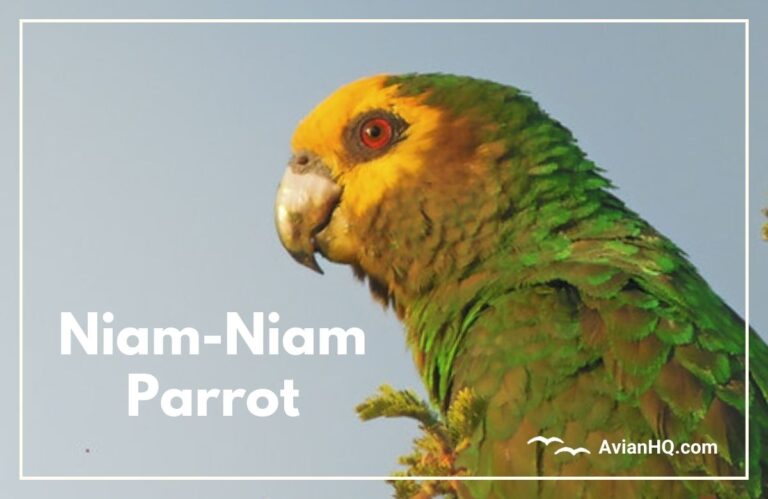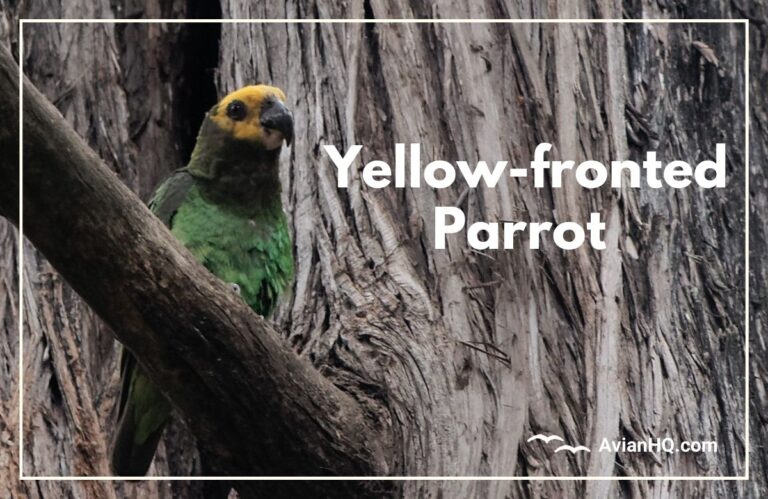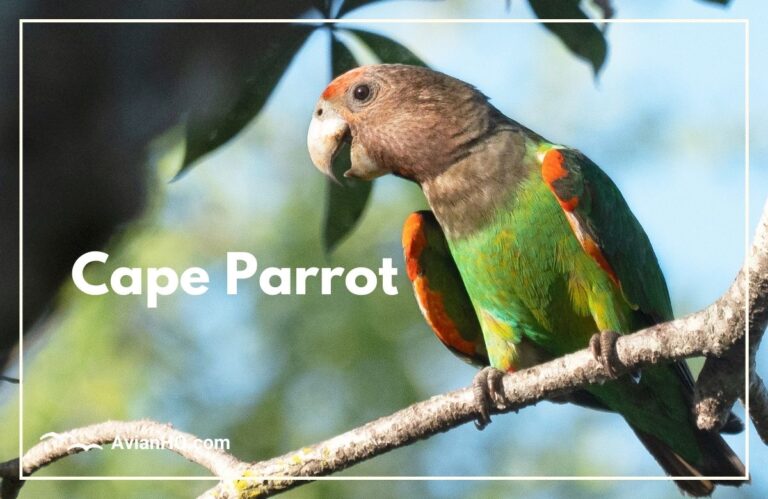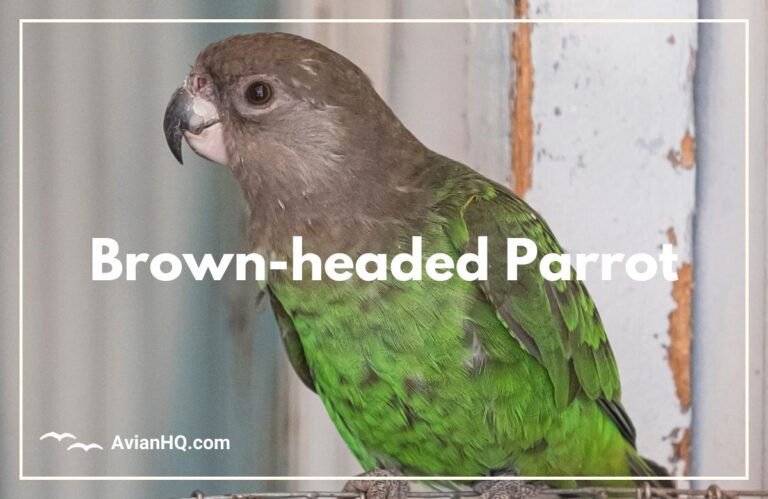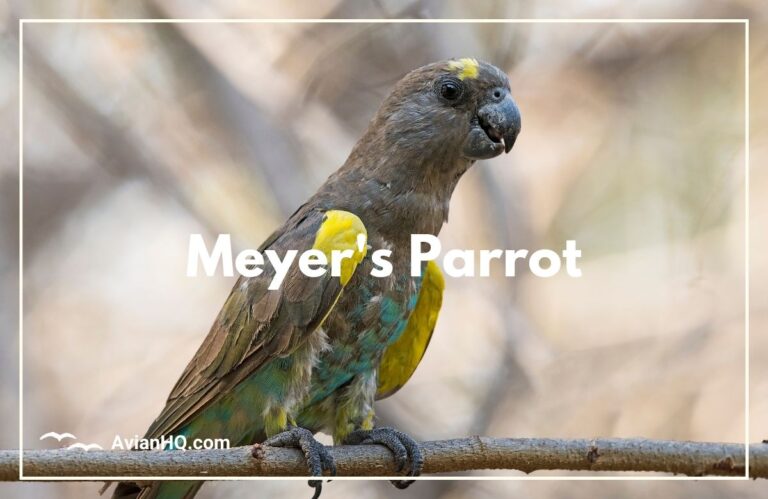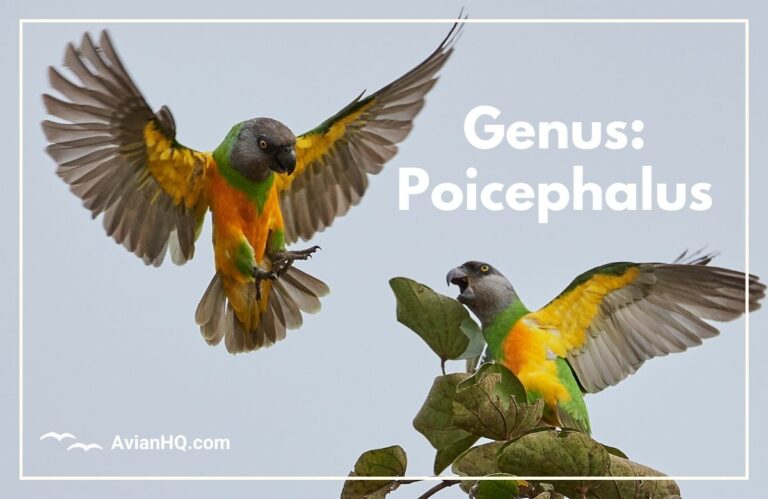Red-bellied Parrot (Poicephalus rufiventris)
The Red-bellied Parrot is a small, colorful bird that makes an energetic and friendly pet. With its bright red belly and orange-red patches under its wings, this little parrot really lives up to its name.
These parrots are native to the savannas and dry woodlands of eastern Africa, where they feed on fruit and nest in the holes of tree trunks. Weighing only about 5 ounces, Red-bellied Parrots grow to be about 9 inches long. They live in small flocks in the wild and enjoy being social.
As pets, Red-bellied Parrots bond strongly with their owners and love to show off. They will whistle tunes, speak a few words, and eagerly perform tricks. Their playful nature provides endless amusement—they hang upside down, wrestle with toys, and roll around on their backs.
“Red-bellied Parrots are natural clowns that thrive on human interaction.”
In this article, you’ll learn all about keeping Red-bellied Parrots as pets. We’ll cover everything from their typical vocalizations to what to feed them, proper housing setups, health issues to watch for, and much more. Whether you already have one of these comical orange-bellied birds or are considering getting one, you’ll find the information here very helpful.
Let’s start by examining exactly what makes this small African parrot unique.
Taxonomy and Classification
The Red-bellied Parrot belongs to the genus Poicephalus, which includes 8 other species of small to medium-sized African parrots. Its scientific name is Poicephalus rufiventris.
Poicephalus comes from the Greek words “poiētēs” meaning creator and “kephalē” meaning head. This refers to these parrots’ crested heads. Rufiventris is Latin for “red belly”, an apt description of the colorful patch on the male Red-bellied Parrot’s underside.
So far, no subspecies of the Red-bellied Parrot have been identified. Within the genus Poicephalus, it is most closely related to Ruppell’s Parrot. In the past, some experts categorized these two types of parrots as the same species.
However, Red-bellied Parrots are slightly larger at about 9 inches (22 centimeters) long compared to Ruppell’s 8 inches (20 cm). Plus, their belly coloring is reversed – Ruppell’s males have gray bellies while females have reddish patches. Modern taxonomy confirms they are distinct species.
The Red-bellied Parrot was first described scientifically in 1845 by the German naturalist Eduard Rüppell. He first encountered the species while traveling through Ethiopia and Somalia. For awhile, the species was also referred to as Rüppell’s Parrot after its discoverer.
Physical Appearance
The Red-bellied Parrot is mostly green with gray on its head, chest, wings, and tail. As the name suggests, adult males have a bright reddish-orange patch on their lower belly. Females lack this colorful marking and instead have green and gray undersides.
These petite parrots reach about 9 inches (22 cm) in length. Their tails add another 3.5 to 4 inches (9-10 cm) of length. Red-bellied Parrots are stocky little birds, weighing approximately 5 ounces (140 grams) on average.
Both sexes have green feathers on the upper portions of their legs. Their wings feature yellowish-green panels on the coverts. The rump and upper tail coverts are more yellow-green with some blue highlights.
Distinct physical features include:
- Dark gray beak – Hooked parrot beak that is blackish-gray in color. The cere at the base is also grayish.
- Red eyes – Bright ruby irises that stand out against darker gray eye rings.
- Gray feet – Zygodactyl toes typical of parrots, with two pointing forward and two back.
Male and female fledglings look similar initially. But after their first molt, the male’s red belly patch and other sexually dimorphic coloration starts to differentiate them.
Like many parrots, Red-bellied Parrots molt once per year. Their irises darken from brown to red as they mature from juveniles into adults over the course of 2 to 4 years.
Habitat and Distribution
In the wild, Red-bellied Parrots inhabit semi-arid regions of Eastern Africa including Ethiopia, Somalia, Kenya, and Tanzania. Their range extends across the Horn of Africa down towards the savanna grasslands of northeastern Tanzania.
These parrots dwell in dry forests and bushlands dominated by acacia trees. They frequent open woodlands, scrublands, and areas of secondary growth. Red-bellied Parrots generally avoid dense vegetation and wet tropical forests.
They thrive at elevations between 2,600 and 6,500 feet (800-2,000 meters). Their habitat tends to be hot, dry, and rocky. The iconic umbrella-shaped acacia trees provide not only food but also nesting sites.
Red-bellied Parrots do not migrate and aren’t currently found outside their native habitat range. However, small introduced populations have become established in areas like Puerto Rico. Within their African range, their population size and conservation status are considered stable.
These hardy parrots are well-adapted to the arid climate of Eastern Africa’s savannas. The scattered acacia trees that dot this landscape provide both sustenance and shelter. Next, we’ll take a closer look at the diet and feeding behaviors of these opportunistic omnivores.
Diet and Feeding
Red-bellied Parrots are opportunistic omnivores. They forage for a wide variety of foods including seeds, nuts, berries, fruits, buds, blossoms, and some vegetation.
Some key components of their natural diet include:
- Figs – Highly nutritious figs, especially from Ficus trees, provide an important food source.
- Acacia pods – The umbrella acacia is a key habitat tree that produces seed pods.
- Fruits – Plums, berries, pomegranates and more from Balanites, Cordia, and other trees.
- Leaves and bark – Acacia leaves and inner bark get consumed seasonally.
These parrots use their strong beaks and feet to access fruits and rip into seed pods. They have been observed hanging upside down to reach figs or acacia pods!
Red-bellied Parrots need to drink regularly due to the hot, arid habitat they occupy. So they are often seen congregating near water holes or rivers to rehydrate and bathe.
In captivity, these parrots should be fed a quality seed mix along with pellets formulated for small parrots. A variety of fruits and veggies provide enrichment and important nutrients too:
- Cooked beans, corn, pasta
- Apples, oranges, pomegranates
- Carrots, celery, fresh corn, peas, peppers
- Endive, dandelion greens, sprouts
A nutritious diet supports good health and proper feather condition in pet Red-bellied Parrots. Changing up food choices also prevents boredom. Next we’ll learn about how these resourceful parrots breed and nest in the wild.
Breeding and Reproduction
During the breeding season, Red-bellied Parrots seek out tree cavities to serve as nest sites. These holes provide a protected space to lay and incubate eggs.
Favored nesting trees include Baobab, acacia, and other large trees with natural hollows or crevices. Nests are often lined with a bed of wood chips or dry plant material.
The breeding season varies across their African habitat range:
- Ethiopia – May to June
- Somalia – November and January
- Kenya/Tanzania – Possibly June to July
In preparation for breeding, pairs engage in courtship feeding and preening behaviors to strengthen their bond. Once bonded, the female typically lays a clutch of 3 eggs.
The eggs are incubated for 24-26 days before hatching. The altricial chicks are blind and covered in just a thin layer of down. Both parents share brooding and feeding the chicks which fledge at around 10 weeks old.
Juveniles reach sexual maturity between 2-4 years old but may not successfully breed until age four. In captivity, mature Red-bellied Parrots can breed throughout the year if provided with suitable nest boxes. Care should be taken though to allow the female periods of rest between clutches.
Now that we’ve covered diet, breeding, and physical traits, we’ll next learn about the behavior and ecology of Red-bellied Parrots.
Behavior and Ecology
Red-bellied Parrots exhibit very social behavior, both with their own kind as well as other species. They live in small flocks ranging from just a mating pair up to family groups of 4-6 birds.
Larger congregations form at prime food or water resources. Groups appear to mingle peacefully though they may compete a bit for choice roosting cavities.
These parrots are active and noisy, making chattering and screeching contact calls as they fly between perches. Their flight is swift and direct thanks to their long, pointed wings.
Roosting and nesting appears to be loosely colonial in nature based on suitable tree cavity sites within their territory. Nests may be situated 65-325 feet (20-100 meters) apart.
In addition to bonds with mates and offspring, Red-bellied Parrots form close relationships with other flock members. Grooming and feeding one another strengthens these ties.
Young fledglings are reliant on parents and siblings to learn key survival skills like identifying edible foods, locating roosts, avoiding predators, and more. Juveniles master flight at around 63 days old.
These highly social parrots fare poorly if isolated. Pet birds deprived of interaction often show signs of stress like screaming, feather plucking, or aggression. Frequent positive human contact is essential.
Next we’ll take a look at the current conservation status for the widespread Red-bellied Parrot species.
Conservation Status
The Red-bellied Parrot is listed as a species of Least Concern on the IUCN Red List of Threatened Species. Their widespread distribution and stable population trend mean they are not currently vulnerable overall.
These adaptable parrots occupy a broad habitat range across Eastern Africa. Population densities fluctuate across their range but exist in sustainable numbers long-term.
However, localized threats from habitat loss and trapping for the pet trade impact specific sub-populations:
- Ethiopia – Uncommon in some areas but abundant in Nechisar National Park
- Somalia – No recent population surveys but described as fairly common
- Kenya/Tanzania – Face trapping pressure in coastal areas
Expanding human activity across Africa does encroach on the arid savanna landscape this species inhabits. Continuous monitoring is necessary to ensure adequate protected brush and woodlands remain.
The Red-bellied Parrot trades legally as a pet and aviary bird in moderate numbers. Over-collection still poses a risk factor in key locations like Kenya. CITES Appendix II listing monitors their export status.
While not yet endangered, proactive habitat conservation and responsible harvesting from the wild provide insurance for the future welfare of these charismatic parrots.
Cultural Significance
The Red-bellied Parrot has limited cultural or historical significance within its native African range. However, indigenous groups have traditionally harvested these birds as a local food source.
Trapping wild parrots for meat continues today across parts of Somalia, Ethiopia, and Kenya. Red-bellied Parrots also face capture for sale as pets and aviary birds.
International commercial trade exacerbates trapping pressure on wild populations. Around 2,000 wild-caught Red-bellied Parrots enter global markets each year according to research by World Parrot Trust.
Beyond serving as a protein source and trade commodity, these parrots hold some cultural symbolism in African folklore. Their bright plumage and harsh cries associate them with bravery.
Seeing or hearing Red-bellied Parrots flying overhead signified war and conflict for the Oromo people of Ethiopia and Kenya. Their movement signaled coming raids by enemy tribes.
For the Turkana people of Kenya, spotting these parrots on migration was an omen of disaster. Their seasonal passage warned of impending epidemics.
So while not integral to ceremonies, rituals, or narratives for most groups, the lively Red-bellied Parrot has inspired imaginative cultural connections to chance, risk, and destiny.
Conclusion
The Red-bellied Parrot stands out for more than just its colorful namesake marking. This pint-sized African parrot brims with personality and intelligence too.
Inquisitive and energetic in nature, Red-bellies thrive when kept engaged socially and mentally. Their strong bonds and playful antics make them delightful lifelong companion pets.
Providing a roomy cage enriched with toys, arranging out of cage time, and offering training sessions prevents boredom-based behavior issues. Interest and affection should be reciprocated through gentle handling techniques.
A nourishing diet fuels an active lifestyle for captive Red-bellied Parrots. And medical care supports longevity upwards of 20-30 years when properly cared for.
From wild origins in the thorny acacia savannas of Eastern Africa to modern homes worldwide, the Red-bellied Parrot continues to charm bird enthusiasts. Its petite profile houses a huge capacity for learning tricks, mimicking speech, and forming meaningful relationships with caretakers.
So whether a new addition or established pet, Red-bellied Parrots light up households across the globe thanks to their vibrant personalities. This fetching “feathered clown” paints smiles on the faces of parrot lovers everywhere.


